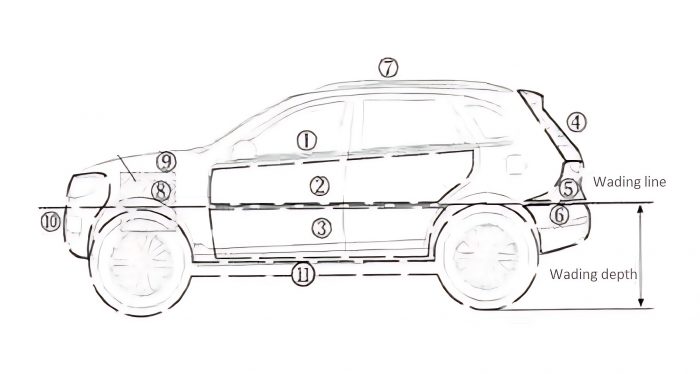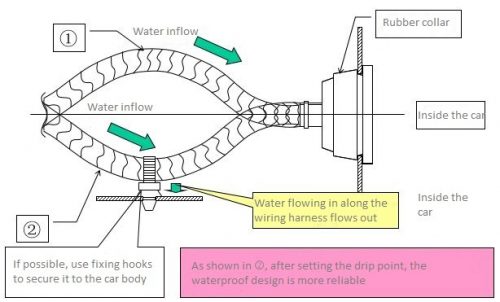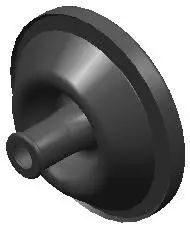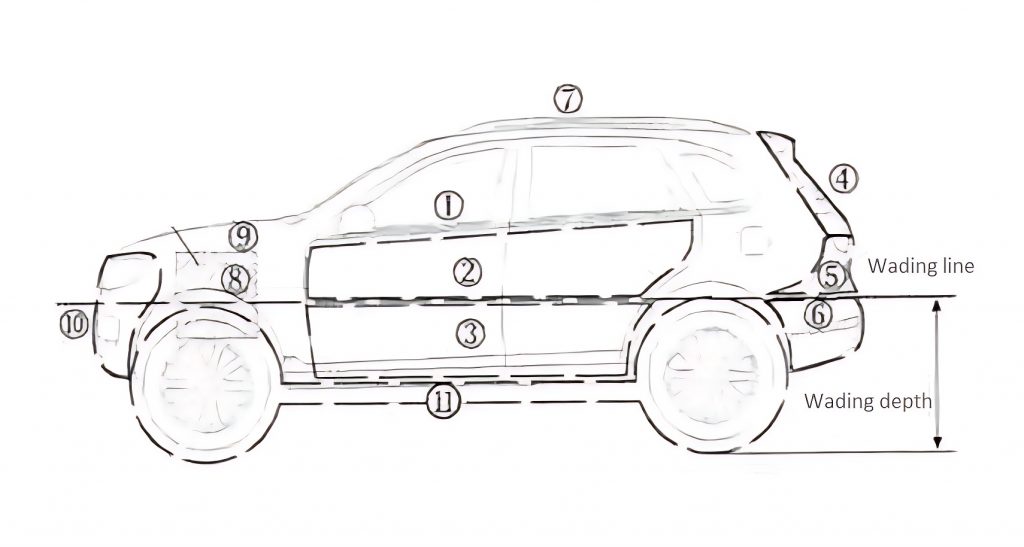Ⅰ.Wading depth
The maximum wading depth of a car refers to the height of the “wading line” from the ground. The “wading line” refers to the height/H of the deepest water that the car can pass when traveling at a speed of 10Km. When designing the electrical system, refer to the vehicle’s wading depth, so that key electrical components are arranged above the “wading line” and electrical components are arranged above the “wading line”. Waterproofing treatment can be effectively implemented. According to the vehicle’s water wading depth and the layout of the vehicle’s electrical components and vehicle wiring harness, the layout area of the vehicle wiring harness is divided into the following figure 1

- The cab and the passenger cabin; 2. The wading line of the four -door line is above the wading line; 3. The section below the wading line of the four -door line; The part of the security rod involved in the wading line; 7. The roof; 8. The inner frame beam of the cabin;
Ⅱ. Wet Area and Wiring Waterproof Area
According to Figure 1, analyze the waterproof requirements of each region in the analysis line beam.
Wet area. The area below the wading line is called a wet area.
Figures 3, 6, 10, 11 and front and rear protection areas 10, 5, 6, cabin area 8, 9, and the roof area 7, and 4 in the back door areas are wet areas.
The wiring bundle in this part includes: front bumper beam, cable bundle (driving room side), power cord (such as engine wiring), rear bumper cable beam, battery positive and negative polar beam, door wire bundle (below area) wading line) And all high -pressure wire beams. The joints on these wires (except the door line) need to be waterproof design, and the parts that are punching to the internal seal should be seal with rubber parts to prevent water from entering the cab. In addition, the punching point on the wiring beam must be protected by thermal reduction tube, and all locations must be protected with glue with the heat shrinkage tube. For the door line, the plug -in below the water line is only a low -voltage speaker, and the plug -in is recommended to waterproof.
Dry area. The rest of the dehumidified area are dry areas.
The wiring beam in the area includes the instrument beam, the top of the car, the left floor wiring, and the right floor wire beam. These wiring plug -ins do not need waterproof, but for the part that is directly in contact with the outdoor, you need to use a sealed tie and buckle. The pores are sealed with rubber parts to avoid indoor water intake.
Ⅲ. Wiring Waterproof Form
Wire beam waterproof is mainly considered from the following aspects:
3.1 Setting dripping points on the layout of the vehicle

3.2 Selection of cable ties
When the wiring harness is fixed on the body sheet metal that is directly connected to the outside world, it is best not to make holes in the body and try to use body studs to fix it with stud-type ties. If there are other restrictions, waterproof ties must be selected for fixation.

3.3 Use of waterproof plug-in
Areas that require waterproof design must choose waterproof connectors, and select appropriate connectors according to the waterproof level of each area.
At present, some domestic OEMs have vague regulations on the waterproof structure of waterproof connectors, such as sealing plugs, blind plugs, etc., and there are no specific regulations. Affected by the price of sealing plugs and blind plugs matching the connector, wiring harness suppliers will use other models instead, but this is likely to make the waterproof design unreliable and affect the functional use of the vehicle’s electrical components. Therefore, it is necessary to supervise and promote the corresponding waterproof experiments and participate in the whole process to ensure the stability of the system.
3.4 Punch and terminal crimping are waterproof
For the wire harness in the wet area, the punching points between the wires must be protected with heat shrink tubing, and all grounding points in the wet area must be protected with heat shrink tubing and glue.
3.5 Waterproof through hole
Wire harness vias need to be waterproof and sealed with suitable rubber parts. Considering the air tightness requirements of the entire vehicle, it is recommended that the interference amount is 1~2mm. For holes larger than 40mm, flanging design is required to ensure air tightness.

Ⅳ. Summary
The waterproof design of the wiring harness is a necessary part of the wiring harness design work. Once the waterproof design fails, it can easily cause abnormal operation of various electrical systems, affect the comfort of the entire vehicle, and even cause great safety hazards. After the design is completed, a waterproof experiment should be conducted to test the reliability of the waterproof design.










